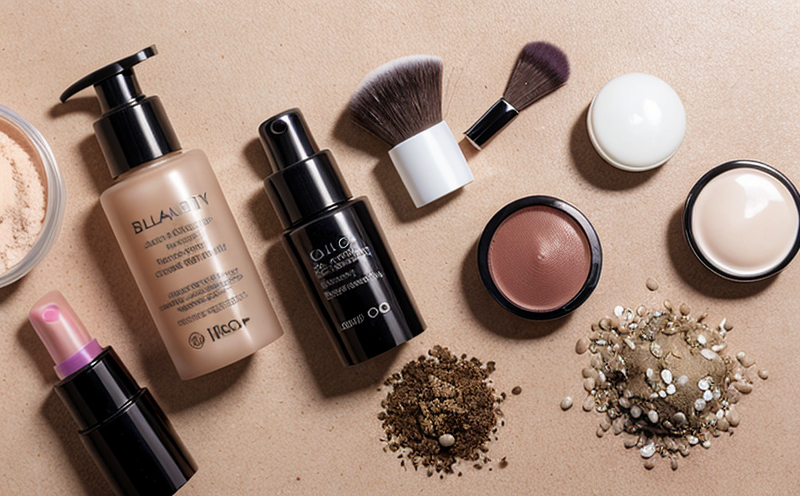Biodegradability Testing of Cosmetic Preservatives
The biodegradability testing of cosmetic preservatives is crucial in ensuring that these ingredients do not persist in the environment, thereby minimizing their impact on ecosystems and human health. As quality managers, compliance officers, R&D engineers, or procurement specialists, understanding this process is essential to meet regulatory standards and ensure product safety.
Cosmetic preservatives are used extensively across various products such as lotions, shampoos, and makeup to prevent bacterial growth and extend shelf life. However, the persistence of these compounds in wastewater can lead to significant environmental concerns. Biodegradability testing aims to determine whether a product or ingredient can be broken down by microorganisms within a specified time frame.
The test involves exposing samples under controlled conditions that mimic natural environments such as soil and water. This helps assess the rate at which the preservative decomposes, providing insights into its potential environmental impact. Compliance with international standards like ISO 17586 is essential for ensuring accurate results and broad acceptance.
For instance, in a typical biodegradability test, samples are incubated in both aerobic (oxygen-rich) and anaerobic (no oxygen) environments to simulate different conditions found in landfills. Samples that degrade significantly above a set threshold within the standard timeframe are considered biodegradable.
The significance of this testing extends beyond mere compliance; it also aids in product innovation by identifying more sustainable alternatives. By choosing biodegradable preservatives, manufacturers contribute positively to environmental conservation efforts while maintaining effective product performance.
Scope and Methodology
- The test aims at evaluating the capacity of cosmetic preservatives to degrade in natural environments.
- It involves incubating samples under controlled conditions that mimic environmental settings like soil, sewage, or marine ecosystems.
- Testing occurs both aerobically and anaerobically to account for diverse biodegradation pathways.
The methodology typically follows internationally recognized guidelines such as ISO 17586. This includes specific protocols for sample preparation, incubation periods, monitoring parameters, and endpoint criteria. Compliance with these standards ensures that results are reliable and comparable across different laboratories and jurisdictions.
Sample preparation involves diluting the preservative in a buffered solution to achieve concentrations relevant to real-world applications. Incubation then takes place over several weeks, allowing sufficient time for degradation to occur. Monitoring includes periodic analysis of residual compounds using advanced analytical techniques like High Performance Liquid Chromatography (HPLC).
At the end of the test period, the degree of biodegradation is quantified by comparing initial and final concentrations. Products that exhibit greater than 60% degradation after the prescribed incubation time are classified as biodegradable according to ISO standards.
Why Choose This Test
- Ensure compliance with international regulations and industry best practices.
- Identify sustainable alternatives for preservatives that pose less risk to the environment.
- Demonstrate corporate responsibility towards environmental sustainability.
- Enhance brand reputation through transparent product formulations.
Selecting biodegradability testing is vital for several reasons. Firstly, it helps companies stay compliant with stringent regulations aimed at reducing harmful chemical footprints in the environment. Secondly, by identifying more eco-friendly preservatives, businesses can innovate and develop products that align better with global trends towards sustainability.
This test also provides valuable data that informs decision-making processes related to ingredient selection. For example, if a particular preservative shows low biodegradability rates, it may indicate the need for reformulation or replacement with more sustainable options. Additionally, the results of this testing can be used in marketing communications, showcasing a company’s commitment to green initiatives and responsible manufacturing practices.
International Acceptance and Recognition
- The ISO standard (ISO 17586) is widely recognized globally for its rigorous testing protocols.
- Countries like the United States, European Union member states, Canada, and Australia accept results from this test.
Biodegradability testing of cosmetic preservatives has gained significant traction internationally due to increasing awareness about environmental impacts. The ISO 17586 standard sets a benchmark for reliable assessment methods, ensuring consistent outcomes across different regions.
In North America, the U.S. Environmental Protection Agency (EPA) and the Canadian Cosmetic, Toiletry, and Fragrance Association (CCTFA) both recognize results from biodegradability tests conducted according to ISO standards. Similarly, in Europe, the European Chemicals Agency (ECHA) considers these tests when assessing potential risks associated with chemical substances.
These recognitions highlight the importance of adhering strictly to international guidelines during testing procedures. Compliance not only simplifies market access but also enhances credibility among consumers who increasingly prioritize environmental considerations in their purchasing decisions. Thus, choosing this test ensures that your products meet global standards and remain competitive in an ever-evolving marketplace.





